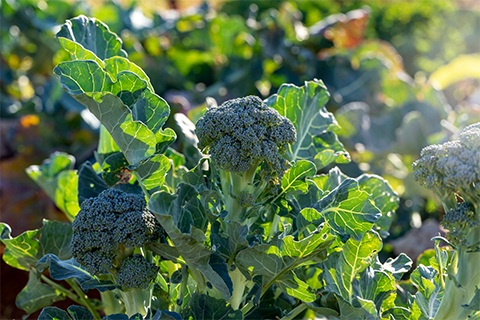Broccoli consumption protects gut lining, reduces disease in mice
Broccoli is known to be beneficial to our health. For example, research has shown that increased consumption of the cruciferous vegetable decreases incidences of cancer and Type 2 diabetes. In a recent study, researchers at Penn State found that broccoli contains certain molecules that bind to a receptor within mice and help to protect the lining of the small intestine, thereby inhibiting the development of disease. The findings lend support to the idea that broccoli truly is a "superfood."

“We all know that broccoli is good for us, but why? What happens in the body when we eat broccoli?” said Gary Perdew, who holds an endowed chair in agricultural sciences at Penn State. “Our research is helping to uncover the mechanisms for how broccoli and other foods benefit health in mice and likely humans, as well. It provides strong evidence that cruciferous vegetables, such as broccoli, cabbage, and Brussels sprouts should be part of a normal healthy diet.”
According to Perdew, the wall of the small intestine allows beneficial water and nutrients to pass into the body but prevents food particles and bacteria that could cause harm. Certain cells that line the intestine — including enterocytes, which absorb water and nutrients; goblet cells, which secrete a protective layer of mucus on the intestinal wall; and Paneth cells, which secrete lysosomes that contain digestive enzymes — help to modulate this activity and keep a healthy balance.
In their study, which published in the journal Laboratory Investigation, Perdew and his colleagues found that molecules in broccoli, called aryl hydrocarbon receptor ligands, bind to aryl hydrocarbon receptor (AHR), which is a type of protein called a transcription factor. This binding, they found, initiates a variety of activities that affect the functions of intestinal cells.
To conduct their study, the researchers fed an experimental group of mice a diet containing 15% broccoli — equivalent to about 3.5 cups per day for humans — and fed a control group of mice a typical lab diet that did not contain broccoli. They then analyzed the animals’ tissues to determine the extent to which AHR was activated, as well as the quantities of various cell types and mucus concentrations, among other factors, in the two groups.
The team found that mice that were not fed broccoli lacked AHR activity, which resulted in altered intestinal barrier function, reduced transit time of food in the small intestine, decreased number of goblet cells and protective mucus, decreased Paneth cells and lysosome production, and decreased number of enterocyte cells.
“The gut health of the mice that were not fed broccoli was compromised in a variety of ways that are known to be associated with disease,” said Perdew. “Our research suggests that broccoli and likely other foods can be used as natural sources of AHR ligands, and that diets rich in these ligands contribute to resilience of the small intestine.”
More broadly, added Andrew Patterson, a professor of molecular toxicology and of biochemistry and molecular biology, “these data suggest that dietary cues, relayed through the activity of AHR, can reshape the cellular and metabolic repertoire of the gastrointestinal tract.”
This article was first published by Pennsylvania State University. Read the original.
Enjoy reading ASBMB Today?
Become a member to receive the print edition four times a year and the digital edition monthly.
Learn moreGet the latest from ASBMB Today
Enter your email address, and we’ll send you a weekly email with recent articles, interviews and more.
Latest in Science
Science highlights or most popular articles

Bacteriophage protein could make queso fresco safer
Researchers characterized the structure and function of PlyP100, a bacteriophage protein that shows promise as a food-safe antimicrobial for preventing Listeria monocytogenes growth in fresh cheeses.

Building the blueprint to block HIV
Wesley Sundquist will present his work on the HIV capsid and revolutionary drug, Lenacapavir, at the ASBMB Annual Meeting, March 7–10, in Maryland.

Gut microbes hijack cancer pathway in high-fat diets
Researchers at the Feinstein Institutes for Medical Research found that a high-fat diet increases ammonia-producing bacteria in the gut microbiome of mice, which in turn disrupts TGF-β signaling and promotes colorectal cancer.

Mapping fentanyl’s cellular footprint
Using a new imaging method, researchers at State University of New York at Buffalo traced fentanyl’s effects inside brain immune cells, revealing how the drug alters lipid droplets, pointing to new paths for addiction diagnostics.

Designing life’s building blocks with AI
Tanja Kortemme, a professor at the University of California, San Francisco, will discuss her research using computational biology to engineer proteins at the 2026 ASBMB Annual Meeting.

Cholesterol as a novel biomarker for Fragile X syndrome
Researchers in Quebec identified lower levels of a brain cholesterol metabolite, 24-hydroxycholesterol, in patients with fragile X syndrome, a finding that could provide a simple blood-based biomarker for understanding and managing the condition.

